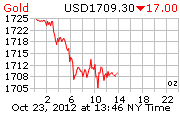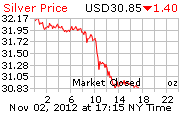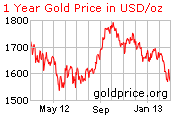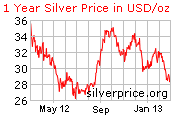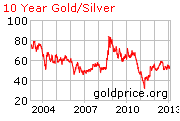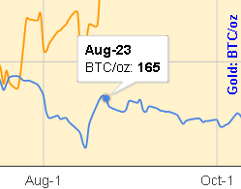Ron Paul on Foreign Policy, Federal Reserve and Liberty
In my earlier post, I mentioned Congressman Ron Paul’s “mission” to audit the Federal Reserve now that he’s been appointed chairman of the Domestic Monetary Policy Subcommittee. Very much in line with expectations, he passionately reiterated his mission in his recent speech at the Conservative Political Action Conference (CPAC).
Remember. The Fed is a key player in the Political Metal price management scheme, and as holders of PMs, it is in our interest to follow its development irrespective of where you live or which currency you earn or save in.
On Foreign Policy - 03m:05s
We got to be doing a lot less a lot sooner not only in Egypt but around the world
Foreign aid is taking money from the poor people of a rich country and giving it to the rich people of a poor country.
On the Federal Reserve - 9m:25s
The Federal Reserve used 4 billion dollars to pass out without congressional approval…. it is our job to check out and find what the Federal Reserve has done, audit them, and find out who their buddies are that they’re taking care of.
The Federal Reserve prints money out of thin air .. they can loan to banks, central banks of the world, to other governments and other international financial institutions and we were nit even allowed to know. They resent thefact that when I asked these questions, that they don’t have to give us this information. That’s why the Bill to audit the Fed is the first step to ending the Federal Reserve.
On Liberty - 15m:40s
The purpose of all political activity from my view point is to promote liberty… Liberty comes from our creator. It doesn’t come from government.
Government should not be allowed to do anything you can’t do. If you can’t steal from your neighbour, you can’t send the government to your neighbour to steal for you. There should be no redistribution of wealth.
More on the Fed in his latest article at Texas Straight Talk
For the past three decades, the Federal Reserve has been given a dual mandate: keeping prices stable and maximizing employment. This policy relies not only on the fatal conceit of believing in the wisdom of supposed experts, but also on numerical chicanery.
Rather than understanding inflation in the classical sense as a monetary phenomenon- an increase in the money supply- it has been redefined as an increase in the Consumer Price Index (CPI). The CPI is calculated based on a weighted basket of goods which is constantly fluctuating, allowing for manipulation of the index to keep inflation expectations low. Employment figures are much the same, relying on survey data, seasonal adjustments, and birth/death models, while the major focus remains on the unemployment rate. Of course, the unemployment rate can fall as discouraged workers drop out of the labor market altogether, leading to the phenomenon of a falling unemployment rate with no job growth.
In terms of keeping stable prices, the Fed has failed miserably. According to the government’s own CPI calculators, it takes $2.65 today to purchase what cost one dollar in 1980. And since its creation in 1913, the Federal Reserve has presided over a 98% decline in the dollar’s purchasing power. The average American family sees the price of milk, eggs, and meat increasing, while packaged household goods decrease in size rather than price.
Loose fiscal policy has failed to create jobs also. Consider that we had a $700 billion TARP program, nearly $1 trillion in stimulus spending, a government takeover of General Motors, and hundreds of billions of dollars of guarantees to Fannie Mae, Freddie Mac, HUD, FDIC, etc. On top of those programs the Federal Reserve has provided over $4 trillion worth of assistance over the past few years through its credit facilities, purchases of mortgage-backed securities, and now its second round of quantitative easing. Yet even after all these trillions of dollars of spending and bailouts, total nonfarm payroll employment is still seven million jobs lower than it was before this crisis began. Read more >>
-
Leave a Reply Cancel reply
The Race to Debase
Monitoring the Currency Wars
Most Recent: Australia Interest Rate Cut
|
Currency Wars Simulation |
Most Popular
Most Recent
Archives
Featured Reviews

16Oct: Jeff Clark (Casey Research)
$2,300 gold by January 2014
05Sep: Bill Murphy (GATA)
$50 silver by year end
13Aug: James Turk (GoldMoney)
We won’t see $1580 gold & $27 silver again
12Aug: Bill Murphy's source
We could see a 100% increase in 90 days.
03Aug: HSBC Analysts
Gold to rally above $1,900 by end 2012
05June: David Bond (SilverMiners)
Gold & Silver may bottom at $1,200 & $18
02June: Don Coxe (Coxe Advisors)
Europe to issue Gold-backed Euro Bonds within the next 3 months
21May: Gene Arensberg (GotGoldReport)
Gold and Silver are very close to a bottom, if one has not already been put in last week
>> More forecasts & forecast accuracy
Featured Videos
|
German Central Bank pledged to the Fed never to buy gold again |
|
George Soros: His role in major world events as agent of the British Empire, as told by LarouchYouth |
 Gold & Silver Interviews (KWN)
Gold & Silver Interviews (KWN)
- Here Is Why Gold & Silver Are Set To Explode Going Forward October 28, 2012
- Here Is What Will Fuel The Move Higher In Hard Assets October 27, 2012
- Greyerz - Two Absolutely Incredible & Key Gold Charts October 26, 2012
- Celente - It’s Not Just Germany’s Gold That’s Missing October 26, 2012
- What To Expect With Gold Assaulting $1,700 & Silver At $32 October 26, 2012
- James Turk - The Entire German Gold Hoard Is Gone October 25, 2012
- KWN Update - Here Is A Huge Key To The Markets October 25, 2012
- Currency Wars Continue To Rage & This Is Positive For Gold October 25, 2012
 Finance & Economics
Finance & Economics
- The Life (So Far) Of Hurricane Sandy October 29, 2012 Tyler Durden
- COINTELPRO Techniques for Dilution, Misdirection and Control of an Internet Forum October 29, 2012 George Washington
- What Fiscal Cliff? Obama Planning Another "Tax Cut" Fiscal Stimulus October 28, 2012 Tyler Durden
- Israel Conducts Air Strike On Sudan Missile Base In 'Dry Run' For Iran Attack October 28, 2012 Tyler Durden
- Supersonic Fiscal Free Fall October 28, 2012 Tim Knight from Slope of Hope
- Charting The Undoing Of Credit-Fueled Globalization October 28, 2012 Tyler Durden
- "Algos-Only" Tomorrow As NYSE Shuts Floor Trading Due To Sandy October 28, 2012 Tyler Durden
- On The Fullness And Boldness Of QE's Manipulation Of American's Behavior October 28, 2012 Tyler Durden



